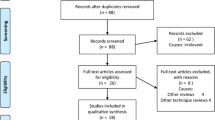Abstract
Introduction
Surgical site infection (SSI) is one of the main causes of postoperative morbidity and mortality. Appendectomy for acute appendicitis is one of the most commonly performed surgical interventions worldwide. The use of ring retractors to protect the wound edge from contaminated intra-abdominal contents may be an effective method to reduce SSI.
Aim
The aim of this systematic review and meta-analysis is to determine whether the use of wound ring retractors reduces SSI rates after open appendectomy.
Methods
A systematic review of randomized controlled trials (RCTs) and meta-analysis of ring retractors was undertaken using the PRISMA guidelines. PubMed, Cochrane RCTs Central Register, CINAHL, and ISRCTN registry were searched for eligible studies. Only studies in which open appendectomy was undertaken were included. The Cochrane Collaboration’s RevMan 5.3 was used for analysis. A subgroup analysis by degree of appendiceal inflammation was performed.
Results
Four RCTs inclusive of 939 patients met eligibility requirements. One trial used single ring while three used double ring protectors. Differences in the definition of SSI, skin preparation, and type and duration of prophylactic antibiotic were found between the 4 studies. The use of ring retractors show some evidence of SSI reduction risk ratio 0.44 [95 % CI (0.21, 0.90)]. On sub-analysis, ring retractor was more effective in more severe degrees of appendiceal inflammation i.e., the contaminated group.
Conclusion
Our review suggests some benefit in using ring retractors to reduce SSI post appendectomy; however the small number and variable quality of the studies suggest the need for more RCTs to confirm these results.






Similar content being viewed by others
References
DiPiro JT, Martindale RG, Bakst A, Vacani PF, Watson P, Miller MT (1998) Infection in surgical patients: effects on mortality, hospitalization, and postdischarge care. Am J Health Syst Pharm 55(8):777–781
Harrop JS, Styliaras JC, Ooi YC, Radcliff KE, Vaccaro AR, Wu C (2012) Contributing factors to surgical site infections. J Am Acad Orthop Surg 20(2):94–101
Olson M, O’Connor M, Schwartz ML (1984) Surgical wound infections. A 5-year prospective study of 20,193 wounds at the Minneapolis VA Medical Center. Ann Surg 199(3):253–259
Setiawan B (2011) The role of prophylactic antibiotics in preventing perioperative infection. Acta Med Indones. 43(4):262–266
Edwards JP, Ho AL, Tee MC, Dixon E, Ball CG (2012) Wound protectors reduce surgical site infection: a meta-analysis of randomized controlled trials. Ann Surg 256(1):53–59
Gheorghe A, Calvert M, Pinkney TD, Fletcher BR, Bartlett DC, Hawkins WJ et al (2012) Systematic review of the clinical effectiveness of wound-edge protection devices in reducing surgical site infection in patients undergoing open abdominal surgery. Ann Surg 255(6):1017–1029
Addiss DG, Shaffer N, Fowler BS, Tauxe RV (1990) The epidemiology of appendicitis and appendectomy in the United States. Am J Epidemiol 132(5):910–925
Khan KI, Mahmood S, Akmal M, Waqas A (2012) Comparison of rate of surgical wound infection, length of hospital stay and patient convenience in complicated appendicitis between primary closure and delayed primary closure. J Pak Med Assoc 62(6):596–598
Moher D, Liberati A, Tetzlaff J, Altman DG, Group P (2010) Preferred reporting items for systematic reviews and meta-analyses: the PRISMA statement. Int J Surg 8(5):336–341
Nystrom PO, Brote L (1980) Effects of a plastic wound drape on contamination with enterobacteria and on infection after appendicectomy. Acta Chir Scand 146(1):65–70
Lee P, Waxman K, Taylor B, Yim S (2009) Use of wound-protection system and postoperative wound-infection rates in open appendectomy: a randomized prospective trial. Arch Surg 144(9):872–875
Ozer MT, Yigit T, Uzar AI, Eryilmaz M, Kozak O, Cetiner S et al (2006) Can incision barrier decrease the risk of surgical site infection after appendectomy? Saudi Med J 27(8):1259–1261
Silva A, Vargas MG, Moreno AA, Becerra HP (2008) Utilidad del retractor elástico abdominal para disminuir el riesgo de infección de herida operatoria en apendicitis aguda. Revista chilena de cirugía 60:527–533
Acknowledgment
We acknowledge the help of Dr Alfredo Silva with the Spanish text and the great help from research librarians in James Hardiman library National University of Ireland Galway.
Author information
Authors and Affiliations
Corresponding author
Ethics declarations
Funding
First author, K Ahmed, is supported by National University of Ireland Galway.
Conflict of interest
Authors declare no conflict of interest.
Ethical approval
N/A for systematic review.
Rights and permissions
About this article
Cite this article
Ahmed, K., Connelly, T.M., Bashar, K. et al. Are wound ring protectors effective in reducing surgical site infection post appendectomy? A systematic review and meta-analysis. Ir J Med Sci 185, 35–42 (2016). https://doi.org/10.1007/s11845-015-1381-7
Received:
Accepted:
Published:
Issue Date:
DOI: https://doi.org/10.1007/s11845-015-1381-7




